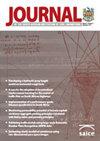An investigation of South African low-income housing roof anchor systems
IF 0.4
4区 工程技术
Q4 ENGINEERING, CIVIL
Journal of the South African Institution of Civil Engineering
Pub Date : 2021-12-31
DOI:10.17159/2309-8775/2021/v63n4a3
引用次数: 0
Abstract
The current roof anchoring methods for houses in South Africa are described in the standard SANS 10400. The adequacy of these prescribed roof anchoring methods for low-income houses (LIHs) is questionable, due to several recently reported failures caused by strong winds. This study quantitively investigates the performance of the prescribed roof anchoring methods through numerical methods, and focuses on LIHs with light-weight roofs supported on single-leaf masonry walls. The masonry walls comprise either solid bricks or hollow cement blocks. The peak wind reaction forces that are expected to occur at the roof anchor systems were determined through a series of static analyses. Finite element analysis techniques were performed to predict the capacity of the roof anchor systems. The predicted resistance of the roof anchor systems was compared to the calculated peak wind reaction forces at the roof anchors to determine the adequacy of the roof anchor systems. The results of the research suggest that, for LIHs constructed from solid bricks, the prescribed roof anchor systems perform poorly under the expected South African strong wind climate. The results indicated that the roof anchors will pull out at peak basic wind speeds of between 27 m/s and 32 m/s, and cracks will develop in the masonry prior to anchor pull-out. This study suggests that further research is required to develop adequate roof anchoring methods for LIHs with light-weight roofs, supported on solid brick walls, and that the relevant codes should be amended accordingly. Furthermore, the results showed that the prescribed roof anchor systems for LIHs constructed from hollow blocks performed well and were able to withstand the expected wind loads under the South African strong wind climate.对南非低收入住房屋顶锚固系统的调查
标准SANS 10400中描述了南非房屋的当前屋顶锚固方法。由于最近报道的几起强风导致的故障,这些规定的低收入房屋屋顶锚固方法的充分性值得怀疑。本研究通过数值方法对规定的屋顶锚固方法的性能进行了定量研究,并重点研究了单层砌体墙上轻型屋顶的LIH。砌体墙包括实心砖或空心水泥块。通过一系列静态分析确定了预计在屋顶锚固系统处出现的峰值风反作用力。采用有限元分析技术来预测顶板锚固系统的承载力。将屋顶锚固系统的预测阻力与屋顶锚固处的计算峰值风反作用力进行比较,以确定屋顶锚固系统是否足够。研究结果表明,对于由实心砖建造的LIH,规定的屋顶锚固系统在预期的南非强风气候下表现不佳。结果表明,屋顶锚将在27 m/s至32 m/s的峰值基本风速下拔出,并且在拔出锚之前,砌体中会出现裂缝。这项研究表明,需要进一步研究,为实心砖墙支撑的轻型屋顶的LIH制定适当的屋顶锚固方法,并应相应修改相关规范。此外,研究结果表明,由空心砌块建造的LIH的规定屋顶锚固系统性能良好,能够承受南非强风气候下的预期风荷载。
本文章由计算机程序翻译,如有差异,请以英文原文为准。
求助全文
约1分钟内获得全文
求助全文
来源期刊
CiteScore
0.70
自引率
25.00%
发文量
19
审稿时长
>12 weeks
期刊介绍:
The Journal of the South African Institution of Civil Engineering publishes peer reviewed papers on all aspects of Civil Engineering relevant to Africa. It is an open access, ISI accredited journal, providing authoritative information not only on current developments, but also – through its back issues – giving access to data on established practices and the construction of existing infrastructure. It is published quarterly and is controlled by a Journal Editorial Panel.
The forerunner of the South African Institution of Civil Engineering was established in 1903 as a learned society aiming to develop technology and to share knowledge for the development of the day. The minutes of the proceedings of the then Cape Society of Civil Engineers mainly contained technical papers presented at the Society''s meetings. Since then, and throughout its long history, during which time it has undergone several name changes, the organisation has continued to publish technical papers in its monthly publication (magazine), until 1993 when it created a separate journal for the publication of technical papers.

 求助内容:
求助内容: 应助结果提醒方式:
应助结果提醒方式:


